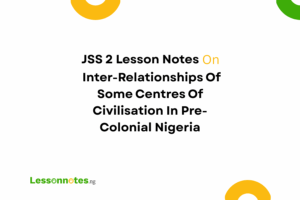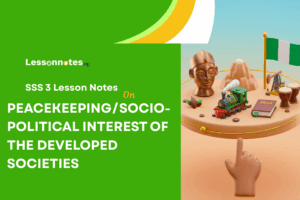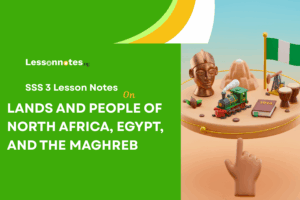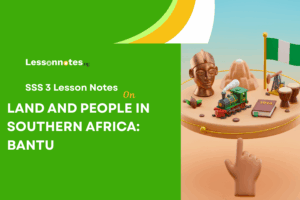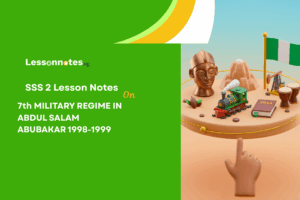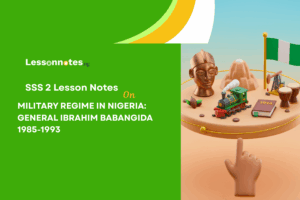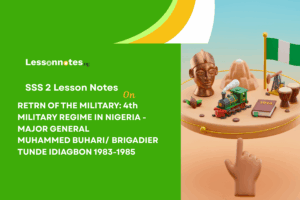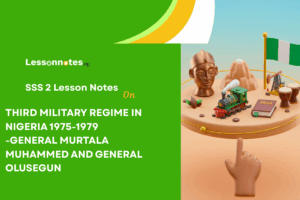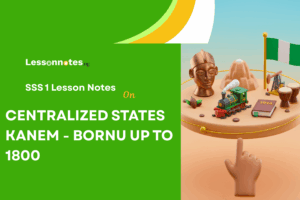Lands And People Of East And Center Africa: Omani(Zanzibar), Buganda And Ethiopia SS3 Nigerian History Lesson Note
Download Lesson NoteTopic: Lands And People Of East And Center Africa: Omani(Zanzibar), Buganda And Ethiopia
East and Central Africa are regions with beautiful landscapes, diverse peoples, and rich histories. In this lesson, we will learn about three important historical kingdoms and territories in these regions: the Omani Sultanate in Zanzibar, the Buganda Kingdom, and the ancient land of Ethiopia. Each has its own unique geography, people, culture, and historical significance that continue to shape the modern nations of East and Central Africa.
Geographical Overview of East and Central Africa
East Africa generally includes:
- Kenya
- Tanzania (including Zanzibar)
- Uganda
- Rwanda
- Burundi
- Ethiopia
- Eritrea
- Somalia
- Djibouti
- South Sudan
Central Africa generally includes:
- Democratic Republic of Congo
- Central African Republic
- Cameroon
- Chad
- Republic of Congo
- Gabon
- Equatorial Guinea
Major Geographical Features
The region has several important physical features:
- Great Rift Valley: A huge crack in the Earth’s surface running from north to south through Ethiopia, Kenya, Tanzania, and beyond. It contains:
- Lakes: Victoria, Tanganyika, Turkana, and many others
- Mountains: Including volcanic mountains
- Fertile valleys good for farming
- Mountains:
- Ethiopian Highlands: High plateaus and mountains
- Mount Kilimanjaro: Africa’s highest mountain (in Tanzania)
- Mount Kenya: Second highest in Africa
- Rwenzori Mountains: “Mountains of the Moon” between Uganda and DRC
- Lakes:
- Lake Victoria: Africa’s largest lake, bordered by Uganda, Kenya, and Tanzania
- Lake Tanganyika: Second deepest lake in the world
- Lake Nyasa/Malawi: Third largest lake in Africa
- Rivers:
- Nile River: World’s longest river, with sources in the region
- Congo River: Second largest river in Africa by volume
- Indian Ocean Coast:
- Long coastline with historic port cities
- Zanzibar and other islands
The Omani Sultanate in Zanzibar
Geography of Zanzibar
- Zanzibar is an archipelago (group of islands) in the Indian Ocean
- Located about 25-50 km off the coast of mainland Tanzania
- Two main islands: Unguja (often called Zanzibar) and Pemba
- Tropical climate with warm temperatures year-round
- Coral reefs surround the islands
- Known for beautiful beaches and fertile lands
Historical Background
- Arab traders had visited the East African coast for centuries
- In the early 1700s, Omani Arabs from the Arabian Peninsula began to gain control
- In 1832, Sultan Seyyid Said of Oman moved his capital from Muscat to Zanzibar
- Zanzibar became the center of the Omani Sultanate’s trading empire
- The Sultanate controlled coastal areas from Somalia to Mozambique
- Zanzibar became known as the “Spice Islands” for its clove, cinnamon, and nutmeg production
Economy and Trade
- Spice Trade: Zanzibar became the world’s largest producer of cloves
- Slave Trade: Sadly, the Sultanate was heavily involved in the East African slave trade
- Ivory Trade: Elephant tusks were a valuable export
- Maritime Commerce: Ships from Arabia, Persia, India, and later Europe came to trade
- Plantation Agriculture: Cloves, coconuts, and other crops on large farms
People and Culture
- Mixed Population: Arabs, Africans, Persians, and Indians
- Swahili Culture: A blend of African and Arab influences
- Language: Kiswahili developed as a trade language
- Religion: Islam was the dominant religion
- Architecture: Stone Town (the old part of Zanzibar City) shows Arab-influenced architecture
- Social Structure: Sultan and Arab elite at the top, with various social classes below
End of the Sultanate
- British influence grew during the 19th century
- Zanzibar became a British protectorate in 1890
- The slave trade was abolished
- In 1963, the Sultanate ended and Zanzibar gained independence
- In 1964, Zanzibar united with Tanganyika to form Tanzania
- Today, Zanzibar is a semi-autonomous region within Tanzania
Legacy
- Stone Town is now a UNESCO World Heritage site
- Swahili culture continues to thrive
- Tourism has replaced spices as the main industry
- The mixture of African, Arab, and Asian influences creates a unique cultural identity
The Buganda Kingdom
Geography of Buganda
- Located in the central region of modern Uganda
- Borders on Lake Victoria (called Nalubaale in the local language)
- Fertile land with adequate rainfall
- Rolling hills and valleys
- Many rivers and streams
- Natural vegetation was mainly tropical forest and grassland
Historical Background
- One of the most powerful kingdoms in the Great Lakes region
- Founded around the 14th century
- Reached its peak in the 18th and 19th centuries
- British colonization began in the 1890s
- Maintained special status during colonial period
- Abolished in 1966 by Milton Obote’s government
- Restored as a cultural institution in 1993
Political Organization
- Ruled by a king called the Kabaka
- Kabaka considered semi-divine
- Kingdom divided into counties (amasaza) led by chiefs
- Complex system of administration
- Royal council (Lukiiko) advised the Kabaka
- Prime Minister (Katikkiro) handled daily administration
- Well-organized military
Economy
- Agriculture: Bananas (matoke), millet, sweet potatoes
- Fishing: Lake Victoria provided abundant fish
- Craft Production: Bark cloth, pottery, ironwork
- Trade: With neighboring kingdoms and, later, coastal traders
- Taxation: Chiefs collected tribute for the Kabaka
People and Culture
- Baganda People: The ethnic group of the kingdom
- Language: Luganda, a Bantu language
- Social Structure: Hierarchical, with the royal clan at the top
- Religion: Traditional beliefs, later Christianity and Islam
- Arts: Music (especially royal drums), dance, storytelling
- Housing: Traditional round or rectangular houses with thatched roofs
- Clothing: Bark cloth was the traditional material before cotton was introduced
Relationship with Colonialism
- Kabaka Mutesa I welcomed the first European explorers in the 1860s
- Kabaka Mwanga II resisted growing European influence
- Kingdom signed an agreement with the British in 1900
- Buganda became part of the Uganda Protectorate
- Chiefs became civil servants in the colonial administration
- Kingdom enjoyed privileges compared to other parts of Uganda
Legacy
- Continues as a cultural institution today
- Current Kabaka is Ronald Muwenda Mutebi II
- Kampala, Uganda’s capital, was originally Buganda’s capital
- Luganda is widely spoken in Uganda
- The kingdom’s political organization influenced modern Uganda
- Kabaka’s palace and tombs are important historical sites
The Ancient Land of Ethiopia
Geography of Ethiopia
- Located in the Horn of Africa
- Dominated by the Ethiopian Highlands (also called the Abyssinian Highlands)
- Elevations range from below sea level in the Danakil Depression to over 4,500 meters in the mountains
- Great Rift Valley runs through the country
- Blue Nile (Abay) River originates from Lake Tana
- Climate varies with altitude – cool in highlands, hot in lowlands
- Diverse landscapes include mountains, plateaus, valleys, and deserts
Historical Background
- One of the world’s oldest continuous civilizations
- Kingdom of Aksum (also spelled Axum) from around 100 CE
- Adopted Christianity in the 4th century (one of the first countries to do so)
- Successfully resisted most attempts at colonization
- Only briefly occupied by Italy (1936-1941)
- Emperor Haile Selassie ruled from 1930-1974
- Communist revolution in 1974 ended the monarchy
- Current federal democratic republic established in 1991
Political Organization
- Ancient monarchy claimed descent from King Solomon and Queen of Sheba
- Emperor (Negus Negast, “King of Kings”) held supreme authority
- Provincial nobles (Ras) governed different regions
- Orthodox Church played important role in governance
- Complex feudal system with various ranks and titles
- Imperial council advised the emperor
Economy and Livelihoods
- Agriculture: Teff (for making injera bread), wheat, barley, coffee
- Animal Husbandry: Cattle, sheep, goats
- Trade: Ancient trade routes connected to Red Sea, Nile Valley, and Indian Ocean
- Crafts: Metalworking, weaving, pottery, manuscript production
- Modern Economy: Coffee is the major export, agriculture employs most people
People and Culture
- Diverse Ethnic Groups: Oromo, Amhara, Tigray, Sidama, and many others
- Languages: Amharic (official), Oromo, Tigrinya, and over 80 other languages
- Religion: Ethiopian Orthodox Christianity, Islam, traditional beliefs
- Unique Calendar: Uses 13-month calendar different from Western calendar
- Script: Ge’ez script for Amharic and Tigrinya languages
- Arts: Religious paintings, illuminated manuscripts, music, cross designs
- Food: Injera (sourdough flatbread) with various stews, coffee ceremony
Religion
- Ethiopian Orthodox Church claims roots back to biblical times
- Christianity became state religion in 4th century
- Maintained unique practices separate from other Christian churches
- Rock-hewn churches of Lalibela are remarkable architectural achievements
- About one-third of population is Muslim
- Judaism practiced by Beta Israel (Ethiopian Jews), though most have moved to Israel
Legacy
- Only African country to successfully resist European colonization (except brief Italian occupation)
- Headquarters of African Union located in Addis Ababa
- Ancient Christian traditions and churches
- Birthplace of coffee
- UNESCO World Heritage sites including Lalibela, Aksum, and Gondar
- Symbol of African independence and pride
Comparing the Three Regions
Political Systems
- Zanzibar: Sultanate with strong foreign (Omani) influence
- Buganda: Indigenous African kingdom with complex administration
- Ethiopia: Ancient empire with biblical connections and religious authority
Cultural Influences
- Zanzibar: Strong Arab and Islamic influence, Swahili culture
- Buganda: Bantu culture with later Christian and Muslim influences
- Ethiopia: Ancient Christian traditions with Middle Eastern connections
Colonial Experience
- Zanzibar: Became British protectorate in 1890
- Buganda: Made agreement with British but lost independence
- Ethiopia: Maintained independence except for brief Italian occupation
Economic Basis
- Zanzibar: Trade, spices, plantation agriculture
- Buganda: Agriculture, fishing, crafts
- Ethiopia: Agriculture, animal husbandry, long-distance trade
Legacy and Modern Significance
Cultural Heritage
All three regions have rich cultural traditions that continue today:
- Architecture (Stone Town, royal buildings, churches)
- Languages (Swahili, Luganda, Amharic)
- Music, dance, and art forms
- Religious practices
- Food traditions
Tourism
Historic sites in all three regions attract visitors:
- Zanzibar’s beaches and Stone Town
- Buganda’s royal tombs and buildings
- Ethiopia’s rock-hewn churches and ancient cities
Political Influence
Each region’s historical political systems influenced modern nations:
- Zanzibar maintained semi-autonomous status in Tanzania
- Buganda’s political structure affected Uganda’s development
- Ethiopia’s imperial system shaped its national identity
Conclusion
The Omani Sultanate in Zanzibar, the Buganda Kingdom, and ancient Ethiopia represent three different models of state formation and development in East and Central Africa. Each had unique geographical settings, political systems, and cultural traditions. Their histories show the diversity and richness of African civilizations before European colonization. Though they have changed over time, these historical regions continue to influence the modern nations of Tanzania, Uganda, and Ethiopia today.
Evaluation
- Describe the geographical features of Zanzibar, Buganda, and Ethiopia.
- Explain how the Omani Sultanate came to control Zanzibar and what their main economic activities were.
- What was the political structure of the Buganda Kingdom and who was its ruler?
- How did Ethiopia maintain its independence when most of Africa was colonized?
- Compare and contrast the cultural influences in Zanzibar, Buganda, and Ethiopia.
Classwork
Answer the following questions:
- Where is Zanzibar located and why was it important historically?
- Describe the role of the Kabaka in Buganda Kingdom.
- What makes Ethiopia’s history unique compared to most African countries?
- List three important geographical features found in East and Central Africa.
- How did trade affect the development of these three regions?


